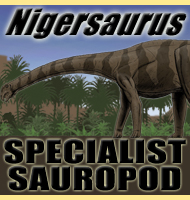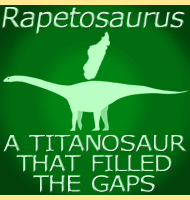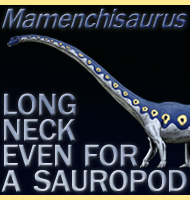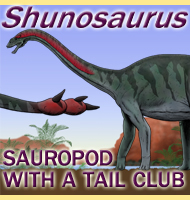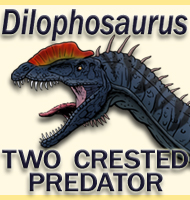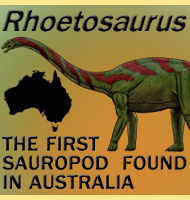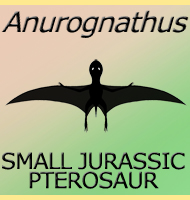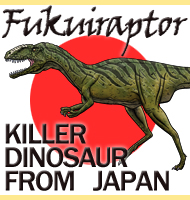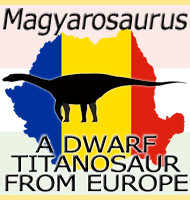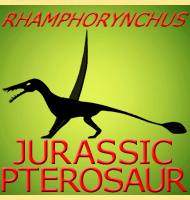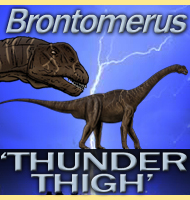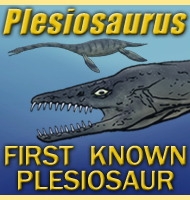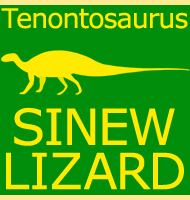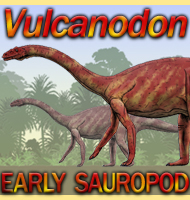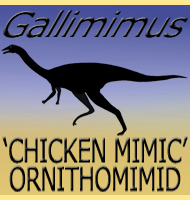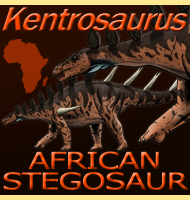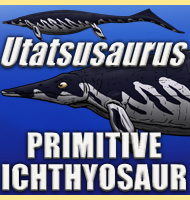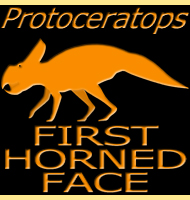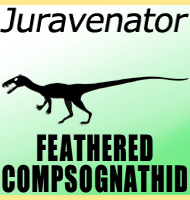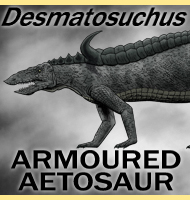


Diplodocus
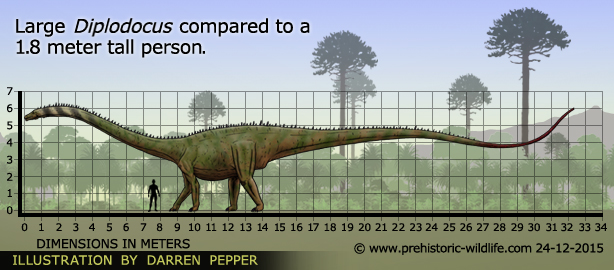
Name:
Diplodocus
(Double beam).
Phonetic: Dip-low-doe-cus.
Named By: Othniel Charles Marsh - 1878.
Synonyms: Diplodocus lacustris,
Seismosaurus hallorum.
Classification: Chordata, Reptilia, Dinosauria,
Saurischia, Sauropodomorpha, Sauropoda, Diplodocidae,
Diplodocinae.
Species: D. longus (type),
D. carnegii, D. hallorum.
Diet: Herbivore.
Size: D. carnegii about 24 meters long. D. hallorum
about 3-33 meters long.
Known locations: USA, Colorado, Montana,
Utah, Wyoming - Morrison Formation.
Time period: Kimmeridgian to Tithonian of the
Jurassic.
Fossil representation: Many specimens, although
some are partial they together reveal the full shape of the dinosaur.
Footprints are also known.
The discovery, naming and
reconstruction of Diplodocus
Two
factors have helped make Diplodocus famous all over
the world. The
first is that for a long time Diplodocus was
thought to be the largest
(at least in terms of length) dinosaur known to walk the Earth.
The second is the large number of skeletal casts of Diplodocus
carnegii that were donated by Andrew Carnegie to numerous
museums
around the world. While these casts still exist to be seen and
studied by all however, discoveries of new dinosaurs have since
displaced Diplodocus from any claim it had to the
title of biggest
dinosaur.
The
first Diplodocus remains were found in 1877 by
Benjamin Franklin
Mudge and Samuel Wendell Williston at Ca�on City, Colorado. The
remains were subsequently studied and named by Othniel Charles Marsh in
a period of American palaeontological history dubbed the ‘bone
wars’. Marsh paid special note of the two long bone growths that
were on the underside of the caudal (tail) vertebra and coined the
name Diplodocus longus, 'long double beam’.
However the vertebrae
that Diplodocus is named for are now known to not
be unique to this
genus, and can be found in many other sauropod genera.
Diplodocus
has the basic sauropod
body shape of a large round body on four legs
with a long tail and neck. Much of the length of Diplodocus
was
actually neck (as much as six meters long) and tail and even so
this granted Diplodocus an incredible body length,
the actual form
would have been quite lightly built. As such even when Diplodocus
was
thought to be the longest dinosaur most considered others such as
Brachiosaurus
to be larger on the grounds of greater body weight.
Today neither of these dinosaurs is considered the largest in the
light of later discoveries such as Argentinosaurus
which is thought to
have been heavier than either one.
The
earliest artistic reconstructions that depicted Diplodocus
in its
presumed habitat of swamps show a sauropod that has a serpentine neck
that is held up almost vertical, a tail that hangs limp across the
ground and legs that sprawl out to the sides like a lizards. For a
start the limbs sprawling out to the sides is an obvious mistake,
something that was pointed out by W. J. Holland. These sprawling
limbs could not have lifted the massive body off the ground, and the
only way that they could have done so was if they were placed below the
body and acted like pillars. Today this seems an obvious conclusion,
but it was not universally accepted until the 1930‘s when
Diplodocus footprints were found that proved
without doubt that
Diplodocus had legs that were under the body.
The
tail is now known to have been carried off the ground and roughly
horizontally level. The whip like ending however still causes some
confusion to its purpose, either being a defence to lash out at
attacking predators, a signalling device which could be used to
create a loud ‘crack’ sound to signal to other Diplodocus,
or
completely unknown function. The neck is also usually envisioned as
being carried horizontal to the ground except when feeding, although
new interpretations suggest that it may have been carried at a
higher angle when not feeding. This is based upon the observation
that all tetrapods (four limbed vertebrates such as amphibians,
bird, mammals and reptiles) carry their heads as high as they can
when they are not preoccupied with other things such as looking for
food. There is no reason to assume that as reptiles the dinosaurs
would be any different, and a 2000 study by Upchurch et al.
suggested that Diplodocus may have held its neck
at up to a forty-five
degree angle. Still the neck of Diplodocus was
not capable of being
bent in S-shaped curves, and regardless of what direction it was
pointing in, up or down, left or right, it would almost certainly
have been kept near straight.
Like
other sauropods Diplodocus is thought to have been
a fully terrestrial
dinosaur that inhabited plains and areas of sparse woodland on the
fringes of denser forests that may have been too overgrown for such a
large creature to move around in. This is very different to the
earliest depictions of this dinosaur that saw it wallowing around in
swamps and lakes to avoid predators and rely upon the water to support
its weight. However when you think about how the water pressure
pressing on the body would have made breathing for Diplodocus
difficult
as well as the fact that the majority of sauropod remains are known
from dry environments, you end up with a better idea as to the kind
of habitats that dinosaurs like Diplodocus lived in.
In
2015 a former long standing species of Diplodocus
called D. hayi was
found to be so different from other Diplodocus
species that it was
granted its own genus called Galeamopus.
This was the same study that
also saw Brontosaurus
resurrected as a valid genus.
Diplodocus the
dinosaur
Diplodocus
is thought to have been a ‘leaf stripper’ of vegetation. This is
suggested by the peg like teeth that point forwards, as well as the
fact that in adults the teeth are only present in the forward portion
of the mouth. Diplodocus had a very particular
wear pattern in that
the teeth are more worn along their sides than on the ends like you
would expect with animals that bit down on food. This means that
Diplodocus fed by closing its mouth around
vegetation so that the stems
of the plant slotted in between the teeth. Diplodocus
would then pull
its head back so that as the stems ran between the teeth the softer
foliage was stripped off and collected inside the mouth. A further
adaptation was the snout of Diplodocus that was
proportionately longer
than other kinds of sauropod, which in the simplest terms means that
Diplodocus could fit a greater length of plants in
its mouth so that it
ended up with a larger amount of vegetation. Juvenile Diplodocus
had
teeth in the back of the mouth as well, and this may indicate that
they pulled their heads to the side rather than just back. This may
have made feeding much easier for them given their smaller size, and
when they grew so large they would almost always be feeding from above
they would only have need for the front teeth.
The
scleral rings (bone that supported the shape of the eye) of
Diplodocus indicate that it was cathemeral. This
means that
Diplodocus was active for short periods throughout
both the day and the
night, and it’s possible that it adapted to such a way of life to
ensure that it had a steady intake of food to keep its massive body
going.
When
it comes down to feeding Diplodocus is usually
envisioned as being a
low browser that kept its neck close to the ground for browsing.
The shorter front legs support this idea as Diplodocus
would have been
in a more comfortable posture for feeding. It has been considered
however that Diplodocus may have been able to rear
up on its hind legs
with its tail acting as a third support so that it could reach up and
feed from the tree canopy as well. If true then this would make
Diplodocus, and possibly similarly built
sauropods, generalists
that could adapt their browsing in accordance to the available plants
of an area. This adaptability would have taken Diplodocus
out of
direct competition with other low browsing herbivores such as
Stegosaurus
which is also known from the same Morrison Formation at
this time. A final feeding theory is that Diplodocus
may have fed
upon submerged aquatic plants by standing on the sides of a lake or
large river and using its long neck to dip its head beneath the surface
to pull up a mouthful of soft water weeds.
Anatomical
details of Diplodocus looked in life are as in
other dinosaurs being
continuously looked at. Usually the head Diplodocus
is recreated with
a thin covering of skin and tissue so that it looks like a simple
fleshed-out skull. It’s a plausible idea though that it may have
had some kind of soft tissue growth that did not preserve although the
Diplodocus skull does not have the large high arcing
supports like some
sauropods have. Still reconstructions exist which show everything
from enlarged resonating chambers that would increase the sound of
calls to small trunks like an elephant. Such reconstructions are of
course pure speculation but they are still valuable tools in pushing
the boundaries of our understanding of dinosaurs in general.
Later
fossil finds have brought the possibility that Diplodocus
may have had
keratinous spines that ran down the back for the entire length of the
animal. Because they were made from keratin this spikes would not
have readily preserved like bones do, but similar spines can be seen
in some other sauropods. In fact the distantly related diplodocid
Amargasaurus
from South America seems to have taken these spines a step
further by having incredibly long spines rising up from the back of the
neck.
How
large sauropods like Diplodocus managed to lay eggs
without them
breaking has been the subject of considerable study but clear
indication to how remains elusive. Some sauropods are thought to have
built nests of soft vegetation that cushioned the fall of the egg,
while others may have managed to squat down. Another theory is that
of an ovipositor which would be a tube of soft tissue like muscles that
an egg passed down on its way to the ground so that it had a controlled
rate of descent and hit the ground softly. This method was depicted
in the BBC series Walking With Dinosaurs which
is why it is often
associated with Diplodocus. Unfortunately no soft
tissue remains
exist to support this, and so it remains as a theory only.
How
much care Diplodocus took in rearing young is also
unknown.
Saltasaurus,
a South American titanosaur seems to have built nests
as indicated by large scale fossil remains found associated with the
species. Another sauropod called Camarasaurus
which lived at the same
time and location as Diplodocus however seems to
have laid eggs in rows
rather than building nests. If the difference is down to ecological
factors then Diplodocus may have been similar to Camarasaurus
in its
rearing behaviour, but as always the answer will be uncertain without
fossil evidence to back up one theory over the other.
After
hatching young sauropods are thought to have headed into dense
undergrowth where they could remain hidden from the eyes of predators.
It’s possible that young Diplodocus did the same
while adults moved
on to fresh feeding grounds and their back teeth suggest a more open
diet. Also the broad snout did not develop until adulthood when only
the front teeth were present, something that again suggests that
young Diplodocus were not as fussy in their
browsing. Study of
Diplodocus bones has shown that the most rapid rate
of growth took
place during the first ten years of life at the end of which the
individual would reach sexual maturity. However even though
Diplodocus could reproduce at this early age fossils
show that it
continued to grow for several years, although at a much slower rate.
How
Diplodocus and other sauropods placed in their
ecosystems food webs is
an interesting subject. When fully grown a Diplodocus
would have
little in the way of natural predators, but first a Diplodocus
would
have to survive long enough to grow up to adulthood. Juveniles would
have had to of been on a constant look out for predators from the
moment of hatching, and with predators like Ceratosaurus
and the even
larger Allosaurus
active in the same area juvenile mortality to
predators may have been incredibly high. This might infer an
r-strategy method of survival for Diplodocus where
a large number of
eggs are laid and hatch out, but a lack of constant parental care
means that many are lost to predators so that only a handful at most
survives to adulthood. This could suggest that juvenile Diplodocus
(and other sauropods) could have formed an important portion of the
prey available to the predators of Jurassic North America. A pelvis
of a Camarasaurus proves that sauropods were eaten
by predators like
Allosaurus, but it does not prove that it was
killed by one.
How
invulnerable adult Diplodocus was to attack is
also a matter of
question. The huge size of Diplodocus was once
thought to be all the
protection that it needed, but eventually animals including
Diplodocus would grow old, as well as occasionally
getting sick and
possibly even injured from something like a fall. These are all
things that predators look for when tracking targets that could be
their next meal. While predators like Allosaurus
were much smaller
than Diplodocus they obviously had no fear of a
challenge, something
which is indicated by fossils that prove Allosaurus
would attack
Stegosaurus, a herbivorous dinosaur that had the
weaponry to kill an
Allosaurus. Additionally fossil material from the
Morrison Formation
has been interpreted as revealing the presence of eleven to twelve
meter long theropods that were even bigger than Allosaurus
(although
some think the material does belong to Allosaurus
which suggests that
some species could grow much bigger than previously thought). Add
on new theropod hunting theories such as mobbing behaviour, where
several theropods that are normally solitary mob and attack an already
weakened individual going their separate ways after the kill, and you
have an ecosystem where Diplodocus faced a day to
day struggle
throughout its life.
Further reading
- Principal characters of American Jurassic dinosaurs. Part VII. On the
Diplodocidae, a new family of the Sauropoda. - American Journal of
Science 3: 160–168.- O. C. Marsh - 1884.
- Diplodocus (Marsh): Its osteology, taxonomy, and
probable habits,
with a restoration of the skeleton. - Memoirs of the Carnegie Museum,
vol. 1 (1901), pp. 1–63. - J. B. Hatcher - 1901.
- A Review of Some Recent Criticisms of the Restorations of Sauropod
Dinosaurs Existing in the Museums of the United States, with Special
Reference to that of Diplodocus carnegii in the
Carnegie Museum. - The
American Naturalist, 44:259–283. - W. J. Holland - 1910.
- The skull of Diplodocus. - Memoirs of the
Carnegie Museum IX; 379–403
- W. J. Holland - 1924.
- Taphonomy and paleoecology of the dinosaur beds of the Jurassic
Morrison Formation. - Paleobiology 6: 208–232. - P. Dodson, A. K.
Behrensmeyer, R. T. Bakker & J. S. McIntosh - 1980.
- Big sauropods – really, really big sauropods. The Dinosaur Report,
The Dinosaur Society Fall:12–13. - G. S. Paul - 1994.
- Feeding mechanisms of Diplodocus. - Gaia 10,
195–204. - P. M. Barret
& P. Upchurch - 1994.
- Supersonic sauropods? Tail dynamics in the diplodocids. -
Paleobiology 23: 393–409. - N. P. Myhrvold & P. J. Currie -
1997.
- Neck posture and feeding habits of two Jurassic sauropod dinosaurs. -
Science 284 (5415): 798–800. - K. A. Stevens & J. M. Parrish -
1999.
- Nostril Position in Dinosaurs and other Vertebrates and its
Significance for Nasal Function. - Science 293: 850–853. - Lawrence M.
Witmer - 2001.
- Reconstruction of the Upper Jurassic Morrison Formation extinct
ecosystem—a synthesis. - Sedimentary Geology 167: 309–355. - C. E.
Turner & F. Peterson - 2004.
- Reappraisal of Seismosaurus, a Late Jurassic
Sauropod. - Proceedings,
Annual Meeting of the Society of Vertebrate Paleontology 36 (5): 422. -
S. Lucas, M. Herne, A. Heckert, A. Hunt & R. Sullivan - 2004.
- Necks for Sex: Sexual Selection as an Explanation for Sauropod Neck
Elongation. - Journal of Zoology 271 (1): 45–53. - P. Senter - 2006.
- Taxonomic status of Seismosaurus hallorum, a Late
Jurassic sauropod
dinosaur from New Mexico. In Foster, J.R., and Lucas, S.G. Paleontology
and Geology of the Upper Morrison Formation. - New Mexico Museum of
Natural History and Science (bulletin 36). pp. 149–161. ISSN 1524-4156.
- S. G. Lucas, J. A. Spielman, L. A. Rinehart, A. B. Heckert, M. C.
Herne, A. P. Hunt, J. R. Foster & R. M. Sullivan. - 2006.
- Paleoneurological evidence against a proboscis in the sauropod
dinosaur Diplodocus. - Geobios 39 (2): 215–221. -
F. Knoll, P. M.
Galton & R. L�pez-Anto�anzas - 2006.
- Geology of the Carnegie Museum Dinosaur Quarry Site of Diplodocus
carnegii, Sheep Creek, Wyoming. - Annals of Carnegie Museum
77 (2):
243. - D. K. Brezinski & A. D. Kollar - 2008.
- Description of a Nearly Complete Juvenile Skull of Diplodocus
(Sauropoda: Diplodocoidea) from the Late Jurassic of North America. -
Journal of Vertebrate Paleontology 30 (2): 442–457. - John A. Whitlock,
Jeffrey A. Wilson & Matthew C. Lamanna - 2010.
- The long necks of sauropods did not evolve primarily through sexual
selection. - Journal of Zoology 285 (2): 151–160. - M. P. Taylor, D. W.
E. Hone, M. J. Wedel & D. Naish - 2011.
- Cranial biomechanics of Diplodocus (Dinosauria,
Sauropoda): testing
hypotheses of feeding behaviour in an extinct megaherbivore. -
Naturwissenschaften 99 (8): 637–643. - Mark T. Young, Emily J.
Rayfield, Casey M. Holliday, Lawrence M. Witmer, David J. Button, Paul
Upchurch & Paul M. Barrett - 2012.
- Evolution of high tooth replacement rates in sauropod dinosaurs. In
Evans, A. R. - PLoS ONE 8 (7): e69235. - M. D. D’Emic, J. A. Whitlock,
K. M. Smith, D. C. Fisher & J. A. Wilson - 2013.
- A specimen-level phylogenetic analysis and taxonomic revision of -
Diplodocidae (Dinosauria, Sauropoda). - PeerJ 3:e857. - E. Tschopp,
O. Mateus & R. B. J. Benson -2015.
- Opinion 2425 (Case 3700) – Diplodocus Marsh, 1878
(Dinosauria,
Sauropoda): Diplodocus longus Marsh, 1878
maintained as the type
species. - Bulletin of Zoological Nomenclature. 75 (1): 285–287. - ICZN
- 2018.
----------------------------------------------------------------------------
Random favourites
 |
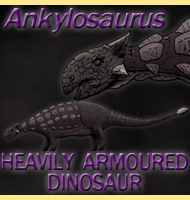 |
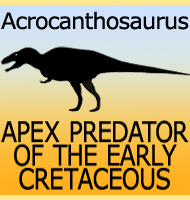 |
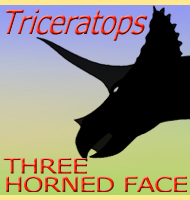 |
